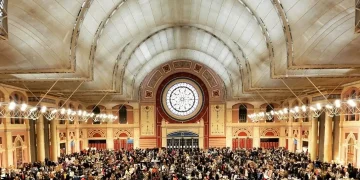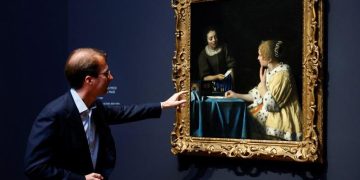In recent years, we’ve witnessed an astonishing surge in the prices of rare collectibles—artworks, vintage cars, sports memorabilia, and even obscure historical artifacts are all seeing sky-high valuations. Auction records are being shattered, with items once considered niche or inaccessible becoming coveted investments. But behind these skyrocketing prices, who is pulling the strings? Is it simply market demand at play, or are there hidden forces shaping the outcome of every bidding war?
Let’s uncover the enigmatic players behind this surge in rare treasure prices and delve into the hidden powers driving the collectibles market.
1. The Ultra-Wealthy: The Silent Giants
At the very top of the pyramid, there’s a group of ultra-wealthy individuals who, despite their quiet presence, wield enormous influence over the collectibles market. These billionaires, often with backgrounds in tech, finance, or entertainment, see rare collectibles not only as status symbols but as a safe and prestigious store of wealth.
The purchasing power of these individuals is staggering. They don’t just buy rare objects for passion—they often buy them as financial assets, secure in the knowledge that high-value collectibles tend to appreciate over time. For them, a Picasso painting or a 1962 Ferrari is far more than a mere possession—it’s a hedge against inflation and an investment in something tangible and finite, unlike stocks or cryptocurrency.
Take, for example, the auction of a rare Da Vinci manuscript that sold for a mind-boggling $50 million in 2024. Behind the scenes, the buyer was rumored to be a prominent Silicon Valley billionaire known for acquiring unique art pieces. When this group of collectors makes a move, the market reacts, and prices soar.
2. Private Collectors and Secretive Networks
While the spotlight often shines on public auctions and sales, the real action is happening behind closed doors. There exists a highly secretive network of private collectors and dealers who trade in high-value treasures without the fanfare of public sales. These collectors often have longstanding relationships with dealers and auction houses, allowing them to acquire valuable pieces off-market before they even hit the auction block.
Many of these collectors are members of exclusive clubs or organizations, which offer access to rare items before they ever become publicly available. This allows them to control the supply of specific collectibles, artificially increasing the rarity and desirability of an item. These underground deals are often conducted with extreme discretion, further driving the price up when the item is eventually released to the public.
3. Auction Houses: The Gatekeepers of Value
Auction houses like Sotheby’s, Christie’s, and Bonhams aren’t just venues for buying and selling—they are also powerful market-makers. The way they present, market, and price items can heavily influence the final outcome of any auction. These institutions curate the narrative surrounding an item’s rarity, importance, and potential value, often leading to bidding wars that push the prices to previously unthinkable heights.
Auction houses are known to employ specialized teams of curators, appraisers, and analysts to ensure that the pieces they sell are positioned in the most desirable light. Additionally, they frequently cultivate relationships with major collectors and investors, often tailoring their sales to attract the right buyers. For example, when a Picasso painting or a rare diamond is listed for sale, these auction houses know exactly how to market it to their target audience—those with deep pockets who are willing to pay top dollar for the chance to own a historical artifact.
Moreover, auction houses can sometimes withhold or delay the sale of certain items, creating a sense of scarcity and increasing demand. By controlling the timing and presentation of valuable collectibles, they can manipulate the market to their advantage, further driving up the prices.

4. Speculators and Investment Funds: The New Wave of Collectible Traders
Over the last decade, we’ve seen the emergence of speculative investors and investment funds that view rare collectibles not as personal treasures but as financial assets. These funds buy up large collections of art, cars, watches, and more, with the explicit goal of reselling them for a profit. In this sense, collectibles are being treated as commodities—assets to be traded for a quick return.
A notable example of this trend is the rise of “alternative investment funds” that specialize in rare watches, classic cars, and fine art. These funds pool money from multiple investors and then purchase large quantities of these high-value items, knowing that their value will likely increase over time. As these funds grow in size and influence, they are driving up demand and, consequently, prices for certain types of collectibles.
One of the most prominent speculative investments in recent years has been the rise of vintage Rolex watches. What was once a niche market for watch enthusiasts is now a multi-billion-dollar industry, with investment funds purchasing limited-edition models and reselling them at enormous markups.
5. Media and Celebrities: The Publicity Machine
The role of media and celebrities in driving up the prices of rare collectibles cannot be underestimated. In the age of social media, a celebrity endorsement or public display of interest can send the price of an item soaring. When a famous figure is spotted with a particular collectible, its value often increases almost overnight due to the influence that celebrity culture has on consumer behavior.
For example, when rapper Jay-Z publicly displayed his extensive collection of rare, vintage luxury watches, interest in these items skyrocketed. Similarly, celebrities such as Kim Kardashian, David Beckham, and LeBron James have been known to increase the value of certain sports memorabilia and high-end fashion pieces simply by associating themselves with them.
Auction houses and dealers are well aware of the power of celebrity endorsement. This is why many high-profile sales now include a heavy dose of marketing, designed to amplify the cultural significance of an item. A public bidding war with the involvement of a famous collector or celebrity can often push prices well above their initial estimates.
6. Global Wealth Shifts: Rising Influence of Asian Collectors
One of the most significant forces reshaping the global collectibles market is the rising influence of Asian collectors. Over the past decade, as wealth has surged in regions like China, Hong Kong, and Japan, the demand for luxury items and rare treasures has skyrocketed. As a result, Asian buyers are now driving up prices for collectibles across the globe, from art to antiques, cars to rare wine.
In particular, Chinese collectors have shown increasing interest in acquiring high-end Western art, luxury watches, and rare stamps. This demographic shift has introduced a new wave of purchasing power into the market, contributing to the rapid price increases we’ve seen in recent years.
Asian billionaires are also diversifying their portfolios by acquiring assets like vintage Ferraris, fine art from Western masters, and rare sculptures. This cultural shift has forced Western collectors to adjust their strategies, and auction houses are now tailoring their sales to cater to this growing market.
Conclusion: A Complex Web of Influences
The surge in rare treasure prices is no accident. Behind the scenes, a combination of ultra-wealthy individuals, secretive collectors, powerful auction houses, speculative investment funds, celebrity culture, and shifting global wealth dynamics are all contributing to the escalating prices of these coveted items.
While the market may appear to be driven solely by demand, the reality is much more complex. The interplay of these hidden forces creates a self-reinforcing cycle, where scarcity is manufactured, demand is fueled, and prices are driven higher. As a result, rare collectibles are no longer just items of personal passion—they have become high-stakes investments with the potential to yield massive returns.
Understanding who is behind this surge in prices and how the market operates is crucial for anyone looking to navigate the increasingly competitive world of rare collectibles. The real question now isn’t just how much these treasures will fetch at auction, but who will be the next to drive prices to new heights.

















































